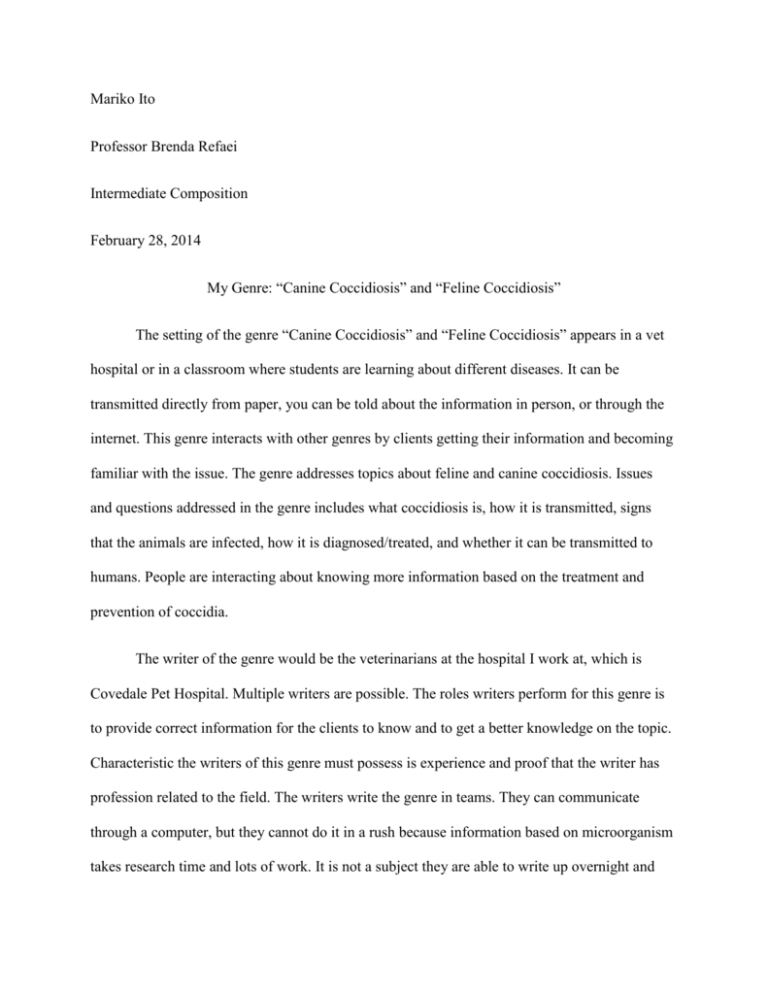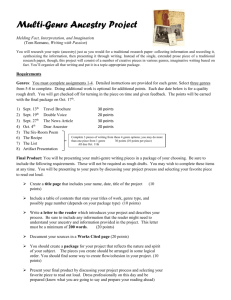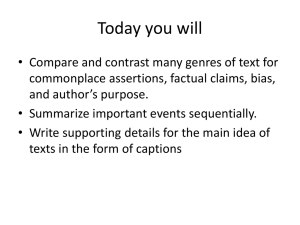Final Draft – Genre Analysis
advertisement

Mariko Ito Professor Brenda Refaei Intermediate Composition February 28, 2014 My Genre: “Canine Coccidiosis” and “Feline Coccidiosis” The setting of the genre “Canine Coccidiosis” and “Feline Coccidiosis” appears in a vet hospital or in a classroom where students are learning about different diseases. It can be transmitted directly from paper, you can be told about the information in person, or through the internet. This genre interacts with other genres by clients getting their information and becoming familiar with the issue. The genre addresses topics about feline and canine coccidiosis. Issues and questions addressed in the genre includes what coccidiosis is, how it is transmitted, signs that the animals are infected, how it is diagnosed/treated, and whether it can be transmitted to humans. People are interacting about knowing more information based on the treatment and prevention of coccidia. The writer of the genre would be the veterinarians at the hospital I work at, which is Covedale Pet Hospital. Multiple writers are possible. The roles writers perform for this genre is to provide correct information for the clients to know and to get a better knowledge on the topic. Characteristic the writers of this genre must possess is experience and proof that the writer has profession related to the field. The writers write the genre in teams. They can communicate through a computer, but they cannot do it in a rush because information based on microorganism takes research time and lots of work. It is not a subject they are able to write up overnight and hope for it to be successful. The reader for this genre includes veterinarians, veterinary technicians, clients, and researchers. There is absolutely more than one reader for this genre. Veterinarians, veterinary technicians, and researchers read this genre to gain knowledge, continue their education, and to experiment on the microorganism so they are able to come up with preventions and medications. Clients read this genre to also gain knowledge and to learn ways on preventing transmission and the different medications for treatment. Readers will read this genre in a waiting room, at their leisure, and when the information is given to them after their animal is diagnosed with the microorganism. The purpose behind writers writing the genre is for the readers to know their information so they are aware of what the microorganism is, how the animals become infected, the clinical signs of the microorganism, how it is diagnosed, and ways to treat the animals. The purpose behind readers reading the genre is for them to gain knowledge as I said previously. The content that is typically included in my samples are information about coccidia, how the microorganism is transmitted, clinical signs of coccidia, diagnostic, and treatment information. The contents that are excluded in the sample are surgical procedures and specific medications that are used. Some examples used in my sample are when the article explains about transmission of coccidia to animals specifically for dogs; “Oocysts (immature coccidia) are passed in the feces of an infected dog. These Oocysts are very resistant to environmental conditions and can survive for some time on the ground. Under the right conditions of temperature and humidity these Oocysts “sporulate”. If the sporulated Oocysts are ingested by a susceptible dog they will release “sporozoites” that invade the intestinal lining cells and set up a cycle of infection in neighboring cells. Dogs may also be indirectly infected by eating a mouse that is infected with coccidia” (Canine Coccidiosis). Evidence that supports this sample includes personal testimony and facts. Doctors have done their research on the microorganism on the internet and read books about coccidia. The ethos for my sample would be the doctor writing the sample. The doctor has spent their time and done their research in school. The pathos for my sample would be that we are trying to provide information to the patients so they know how to prevent their animal from getting coccidia. An example from the sample is, “Good hygiene and proper disposal of dog feces are important in minimizing risk of transmission of all canine parasites to humans, or to other animals” (Canine Coccidiosis). The logo for my sample is when the sample persuades the reader about getting rid of coccidia before it transmits to other animals with a reason. For example, “Re-infection of dogs is common so environmental disinfection is important. The use of diluted chlorine bleach [one cup (250 ml) of bleach mixed in one gallon (3.8 L) of water] is effective if the surfaces and premises can be safely treated with it” (Canine Coccidiosis). The text in the genre is structured by a question and answer format. The question is in bolded letters and the answer is right below the question. For example, “What is coccidiosis?” (Feline Coccidiosis). The type of sentences my genre typically uses is complete sentences. The answers to the question are about four sentences to a paragraph long. The sentences are pretty simple. It does not go into too much detail about the microorganism, but it explains the main points. The sample is passive. For example, “Coccidiosis is an intestinal tract infection caused by a one-celled organism or protozoa called coccidia” (Feline Coccidiosis). The diction that is most commonly used are medical words like antibiotics, intestinal tract infection, dehydration, abdominal distress, vomiting, severe, watery diarrhea, parasites, and sulfa-type drug. There is a type of jargon used in my sample. Not everybody knows the term coccidiosis, Cryptosporidium, sulfa-type drug, and Toxoplasma. There are no slangs used in my samples. The writer’s voice is very informative. The point in my sample is to try to inform the audience about the microorganism and ways to prevent them and to treat the parasite. To understand or appreciate the genre “Feline Coccidiosis” and “Canine Coccidiosis” participants have to know what exactly coccidia is, which is explained in the first part of the sample that I chose. Animal owners, researchers, veterinarians, veterinary technicians, and students learning about microorganism would be the ones invited into the genre. Anyone that does not have an interest in learning about coccidia or people not involved in the medical field may be ones that are excluded out of the genre. The role for the writer that is encouraged in this genre is for the author to write information about the microorganism so they are able to let the readers know more about the microorganism and they will become more educated. The values, beliefs, goals, and assumptions that is revealed through the genre’s patterns is for the writer to be able to educate the readers about coccidia so they are able to treat their animals and know how to take care of the situation. The subject of the genre is about coccidia. The genre explains about how the animal was infected with coccidia, what the clinical signs of coccidia are, how coccidia is diagnosed and treated and if the parasite is able to infect humans. The content that is considered important is how the article is written and who it is written towards. The content that is ignored is the author who wrote the article and the date it was published. Some actions that this genre helps make possible is how the author wrote the article. It is easy to understand and read. Since the article is in a question and answer format the reader can easily locate the question and hopefully the passage answers it to their full expectations. The action that this genre made difficult is ways of preventing coccidia transmission from animal to animal. Even though the article explains about different ways of treating coccidia, like bleaching the infected area and dispensing antibiotics, it does not go too much into detail about how to prevent getting coccidia. My genre is defined as a disease article in animals specifically for dogs and cats. For my samples I am able to find experts to help me define it because the doctors at my pet hospital wrote the article about coccidia. There are also researcher’s that has worked on my samples. The genre has evolved over time by the information written on the article. The information written was not the same 30 years ago. There are more information provided to the readers and they are able to better understand the disease. The genre is similar to other genres by having a title, there are pictures explaining the cycle of a coccidia and a picture of a coccidia so readers know what they look like, and the sample is written in a question and answer format. What makes the genre different is that my genre does not have an author written and it also does not have a published date. Work Cited Obert, William. “Canine Coccidiosis.” Canine Coccidiosis (n.d.): 1-2 Web. 14 Feb. 2014 Obert, William. "Feline Coccidiosis." Feline Coccidiosis (n.d.): 1-2. Web. 14 Feb. 2014.








